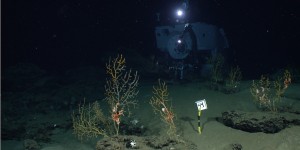
The 2010 Deepwater Horizon oil spill had a serious negative impact on deep-sea coral communities more than seven miles from the spill site in the Gulf of Mexico. That’s the verdict after a series of underwater investigations led by Penn State Professor of Biology Charles Fisher.
The study, which included scientists from Haverford College, Temple University, the U.S. Geological Survey, and the Woods Hole Oceanographic Institution as well as Penn State, grew out of an initial research cruise in late October 2010—approximately six months after the Deepwater Horizon spill.
As part of an ongoing effort funded by the Bureau of Ocean Energy Management and the National Oceanic and Atmospheric Administration, the research team used the remotely operated vehicle (ROV) Jason II to examine nine sites at distances greater than 12 miles from the Macondo well, which had been capped three months previously after spilling an estimated 160 million gallons of oil into the Gulf. They found deep-water coral communities unharmed.
However, when the ROV explored another area seven miles southwest of the spill site, the team was surprised to discover numerous coral communities covered in a brown flocculent material and showing signs of tissue damage.
“We discovered the site during the last dive of the three-week cruise,” says Fisher, chief scientist for the original mission. “As soon as the ROV got close enough for the corals to come into clear view, it was clear to me that something was wrong. I think it was too much white and brown, and not enough color on the corals and brittle stars. Once we were close enough to zoom in on a few colonies, there was no doubt that this was something I had not seen anywhere else in the Gulf: an abundance of stressed corals, showing clear signs of a recent impact. This is exactly what we had been on the lookout for during all dives, but hoping not to see anywhere.”
Because of the timing and unprecedented nature of this observation, the scientists rapidly organized a second research cruise, which began barely a month after their return to land. This rare opportunity to return to a deep-water site so quickly was made possible with funding from the National Science Foundation’s RAPID Collaborative Research grant program.
This time, the team used the autonomous underwater vehicle Sentry to map and photograph the ocean floor, and the three-passenger, robotic-armed submersible Alvin to get a better look at the distressed corals. During six dives in Alvin, the team collected sediments and samples of the corals and filtered the brown material off the corals for analysis.
To identify the oil found in the affected communities, Helen White, a geochemist at Haverford College, worked with Christopher Reddy and Robert Nelson at Woods Hole using an advanced technique Reddy and Nelson pioneered called comprehensive two-dimensional gas chromatography. The method, which separates oil compounds by molecular weight, allows scientists to essentially “fingerprint” oil and determine its source. This exacting analysis, coupled with that of photographs of individual corals taken at the site, yielded strong evidence that the coral communities were impacted by oil from the Macondo well spill.
“These biological communities in the deep Gulf of Mexico are separated from human activity at the surface by 4,000 feet of water,” White says. “We would not expect deep-water corals to be impacted by a typical oil spill, but the sheer magnitude of the Deepwater Horizon oil spill and its release at depth make it very different from a tanker running aground and spilling its contents. Because of the unprecedented nature of the spill, we have learned that its impacts are more far reaching than those arising from smaller spills that occur on the surface.”
Fisher adds, “Our ongoing work in the Gulf will allow us to better understand the long-term effects of the spill on the deep sea, and to constrain the footprint of the impact zone for deep-water corals around the Macondo well.”
Barbara Kennedy, Penn State University


